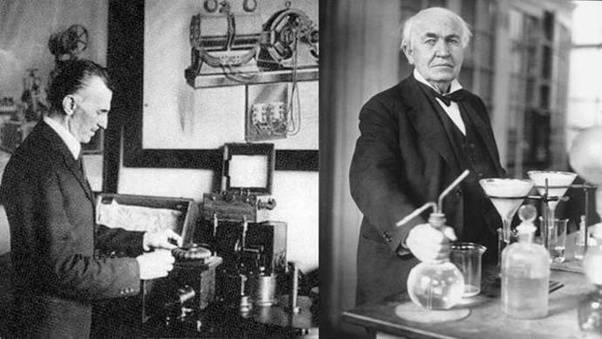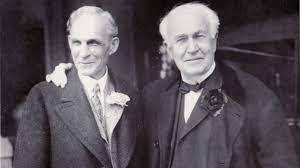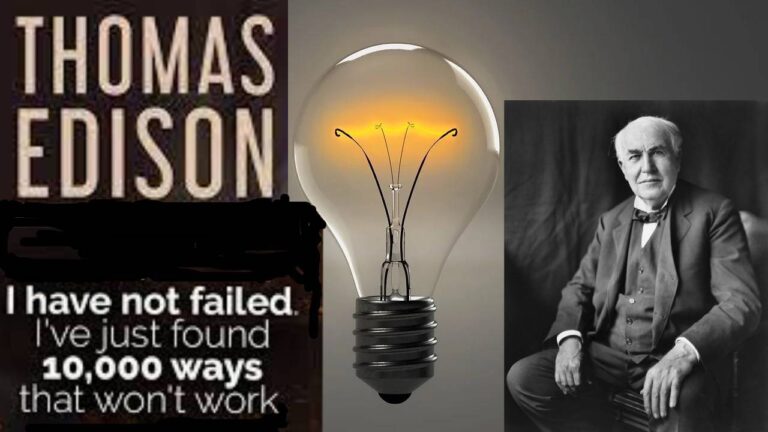Thomas Edison invented many things that changed the world. His most famous inventions are the light bulb, the phonograph (which could record and play sound), and the motion picture camera. He also improved the telegraph and telephone. These inventions had a huge impact on how we live today. Let’s have a brief look at his life events.
When was Thomas Edison Born and Died
Edison was born on February 11, 1847, in Milan, Ohio, and died in 1931, leaving behind a legacy of inventions. His family had moved to the U.S. from Canada. He was the youngest of seven kids and wasn’t always healthy as a child. When he was young, his family moved to Port Huron, Michigan. Edison didn’t do well in school, and when one of his teachers called him “addled,” his mom decided to teach him at home. Edison always said that his mother’s faith in him was what made him who he was.
Thomas Edison Childhood Struggles
Even as a kid, Edison loved tinkering with mechanical things and doing chemistry experiments. At just 12 years old, he got a job selling newspapers and candy on a train. He was so curious that he set up a tiny lab on the train to do experiments and even started his newspaper. But a fire eventually put an end to those experiments.
When did Thomas Edison go Deaf
Around this time, Edison began losing most of his hearing. No one knows why, but he never let it stop him. He used it to help him focus more on his work, even though it made him a bit more of a loner. Despite all the challenges he faced, Edison went on to become one of the most important figures in the world of technology.
How Many Patents did Thomas Edison have
In his life, Thomas Edison had 1,093 patents, which is incredible. But Edison wasn’t just an inventor—he was also a smart businessman who knew how to sell his ideas to the world. His life was full of projects and tough legal battles over his inventions.
The Automatic Telegraph Repeater (1863)
When Thomas Edison was just 16, he created his first invention, the Automatic Telegraph Repeater. This smart device sent telegraph messages between stations without needing people there. Even though Edison didn’t patent it, it was his first step into a world of amazing inventions.
The Electric Vote Recorder (1869)
Edison’s first patent was the Electric Vote Recorder, which let people vote “yes” or “no” with switches. Unfortunately, it didn’t catch on with Congress, but this setback didn’t stop Edison. Instead, it made him even more determined to invent new things.
The Quadruplex Telegraph (1875)
In 1875, Edison invented the Quadruplex Telegraph. This cool gadget could send two messages at once in both directions on the same wire. It was a big deal for communication and set the stage for future tech.
The Phonograph (1877)
Edison became famous in 1877 for inventing the Phonograph. This machine could record and play back sound. His early version used a tinfoil cylinder, and it turned out to be a huge leap forward in sound recording.
The Carbon Microphone (1877)
That same year, Edison made the Carbon Microphone, which changed how we talk to each other. It turned sound into electrical signals and was used in telephones and radios for many years. Even though he had some legal troubles, Edison was recognized as the real inventor.
Incandescent Light Bulb Improvement (1879)
In 1879, Edison improved the light bulb, making it last much longer. His version with a carbon filament could glow for over 1,200 hours. This was a game-changer, bringing electric light to homes and streets everywhere.
Electric Power Distribution (1880)
Once Edison had the light bulb working well, he started working on getting electricity to everyone. In 1880, he patented a system for distributing electric power and set up the first electric utility in New York City. This helped start the “War of Currents” with Nikola Tesla, who had different ideas about power.
Wireless Telegraph (1885)
In 1885, Edison worked on the Wireless Telegraph, which let ships communicate without wires. Although it didn’t use electromagnetic waves like we do today, it showed Edison’s knack for pushing the limits of technology.
Kinetograph & Kinetoscope (1891)
The 1890s were exciting for movies, thanks to Edison. He and W.K.L. Dickson invented the Kinetograph, a motion picture camera, and the Kinetoscope, a device to watch films. These inventions helped create the modern film industry.
The Fluoroscope (1896)
After Wilhelm Röntgen discovered X-rays, Edison developed the first practical Fluoroscope in 1896. This device lets doctors see inside the body in real time, changing medicine forever.
Alkaline Storage Battery Improvement (1904)In 1904, Edison turned his attention to improving the Alkaline Storage Battery. His advancements in this technology helped pave the way for portable power sources, influencing everything from electric vehicles to modern-day electronics.
Nikola Tesla and Thomas Edison Relationship

The relationship between Thomas Edison and Nikola Tesla was both collaborative and contentious. Here’s a snapshot of their dynamic:
Early Collaboration of Nikola Tesla and Thomas Edison
- Tesla Joins Edison:
In 1884, Nikola Tesla moved to the U.S. and briefly worked for Edison, hoping to improve direct current (DC) motors.
- Disagreements Emerge:
Tesla preferred alternating current (AC) for power transmission, which Edison rejected and saw as a threat to his DC system.
The War of Currents
- Parting Ways:
In 1885, Tesla left Edison’s company after unmet promises of financial rewards for his work.
- AC vs. DC:
A fierce rivalry, known as the “War of Currents,” ensued. Edison criticized AC, even staging dangerous demonstrations to highlight its flaws.
- Westinghouse and AC’s Victory:
Entrepreneur George Westinghouse supported Tesla’s AC system. AC proved better for long-distance transmission and became the standard.
Beyond the Rivalry
- Mutual Respect:
Despite their conflicts, there was mutual respect. Edison recognized Tesla’s brilliance, and Tesla acknowledged Edison’s practical engineering skills.
- Tesla’s Struggles:
Tesla faced financial difficulties throughout his life, but his inventions were crucial to modern electrical systems and wireless technology.
In summary, Edison and Tesla’s relationship was a mix of collaboration and rivalry. Edison is often associated with the light bulb, while Tesla’s groundbreaking work on AC power continues to shape our world.
Thomas Edison Facts for Kids
Here are some fun and simple facts about Thomas Edison for kids:
- Early Start: Thomas Edison was born on February 11, 1847, in Milan, Ohio. He was the youngest of seven children.
- Young Inventor: As a kid, Edison sold newspapers and candy on a train. He even set up a small lab on the train to do experiments!
- Hearing Loss: Edison lost most of his hearing when he was young. He thought it helped him focus better on his work.
- Famous Inventions: Edison is best known for inventing the light bulb, the phonograph (an early music player), and the motion picture camera.
- Big Achiever: Over his lifetime, Edison got 1,093 patents for his inventions. That’s a lot of new ideas!
- Phonograph Passion: Edison loved the phonograph so much that he called it his “baby” and worked on it for 52 years.
- Workaholic: Edison worked long hours. He would often sleep in his lab to be close to his projects.
- Inventor’s Lab: Edison had a huge workshop in Menlo Park, New Jersey, where he and his team worked on many of his inventions.
- Battles with Tesla: Edison had a famous rivalry with another inventor named Nikola Tesla. They disagreed about how electricity should be delivered—DC (Direct Current) versus AC (Alternating Current).
- A Family Man: Edison married twice and had six children. He often involved his family in his work and experiments.
These fun facts show how Edison’s curiosity and hard work helped shape the modern world!
Thomas Edison Last Breath
Henry Ford, who was a famous car maker and a big fan of Edison, wanted to remember his friend especially. He asked Edison’s son, Charles, to capture Edison’s last breath in a test tube. Charles had eight test tubes ready and kept them close to his dad as he was dying. After Edison’s last breath was caught, Dr. Howe sealed the test tubes with paraffin to keep them safe.
Thomas Edison and Henry Ford Friendship

Henry Ford kept one of these test tubes as a memento. After Ford died in 1947, his things, including the test tube, were given to a museum in Dearborn, Michigan. The test tube was found in 1978 and has been on display at the Henry Ford Museum ever since.
People sometimes wonder if this story is exactly true, but it’s a fascinating part of Edison’s legacy!

